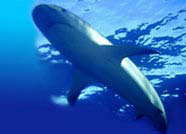


Blue shark

 |
 |
 |
|||
| Home | Evolution
| Classification
| Glossary | Biology
| Behavior | Shark
Repellent | Shark
Conservation | Do's &
Don'ts | Did You Know?
Blue shark |
 |
||||
|
Scientific name: Prionace glauca
 Although preferring warmer waters, blue sharks chase fish and squid to depths of 600m (2,000 ft), enduring cold water and great pressures to feed on their favorite prey. A nomadic species, they can travel hundreds of miles each year. They conserve energy by riding the North Atlantic Gyre on their annual migrations of around 3,000km (1,800 miles). They are not considered dangerous to humans, although they have been implicated in attacks on survivors of ship or air disasters. Blue Sharks are a viviparous species. Females give birth to 25-50 pups, (although a litter of 135 individuals was once recorded) after a gestation period of 9-12 months. Although blue sharks are one of the fastest growing, most abundant sharks, they are heavily over fished. They are commonly fished for their fins, which are used in the production of shark-fin soup. They may also end up as bycatch in the swordfish and tuna fishery. Statistics: The largest recorded blue shark was 3.83m, but females’ average 2.76m and males 2.46m. Blue Shark Classification:
|
|||||
| Sitemap | Reach To Us | Jimtrade - Business Directory of India | |||||